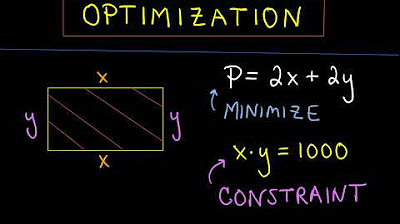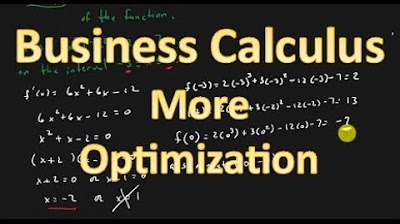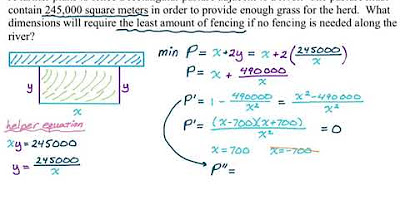Calculus - Optimization Problems
TLDRThis video delves into optimization problems, illustrating how to maximize or minimize functions using various examples. It covers topics such as fencing off a rectangular field with a river boundary, minimizing the cost of manufacturing a cylindrical can, finding the point on a parabola closest to a given point, and determining the largest inscribed rectangle in a semicircle. The video demonstrates the process of setting up equations, taking derivatives, and solving for critical numbers to find optimal solutions, emphasizing the importance of transforming the function into a single variable and applying the right mathematical techniques.
Takeaways
- 📈 Optimization problems typically involve finding the maximum or minimum value of a function, often subject to certain constraints.
- 📌 To solve optimization problems, you often need to work with a function and an equation that relates the function to one variable.
- 🔍 For the farmer fencing problem, the goal is to maximize the area of a rectangular field with a given amount of fencing.
- 📏 The dimensions of the field that maximize the area are found by setting the derivative of the area function equal to zero and solving for the variable.
- 📊 In the cylindrical can problem, the objective is to minimize the surface area, and hence the cost of manufacturing the can, given a fixed volume.
- 🧩 To minimize the surface area of the cylinder, express the dimensions in terms of a single variable using the volume constraint, then take the derivative and find the critical points.
- 🏞 For the parabola problem, the task is to find the point on the parabola that is closest to a given point (1,4).
- 🤔 In the boat crossing problem, the goal is to find the optimal landing point to reach a destination point as quickly as possible, considering the boat's rowing and running speeds.
- 🛶 The optimal landing point is determined by minimizing the total time taken, which involves both rowing and running times, and is subject to the constraints of the river's width and the boat's speed.
- 📐 The maximum area of a rectangle inscribed in a semicircle is found by expressing the rectangle's dimensions in terms of the semicircle's radius and solving for the maximum area.
- 🎓 Optimization problems require a combination of algebraic manipulation, understanding of geometric constraints, and the application of calculus, particularly the process of taking derivatives and finding critical points.
Q & A
What is the main objective of the farmer in the optimization problem?
-The main objective of the farmer is to use 2400 feet of fencing to fence off a rectangular field along a straight river, maximizing the area of the field.
How does the farmer maximize the area of the rectangular field?
-The farmer maximizes the area by determining the dimensions of the rectangle that yield the largest area, given the constraint of 2400 feet of fencing. This involves setting up an equation with the given fencing length and the area function, then solving for the critical points to find the maximum area.
What is the equation that represents the area of the rectangular field?
-The equation representing the area of the rectangular field is Area = x * (2400 - 2x), where x is the length of the side of the rectangle parallel to the river.
What is the domain of x in the optimization problem of the farmer's field?
-The domain of x is between 0 and 1200 feet. This is because x cannot be negative (as that would imply a negative side length), and if x were greater than 1200, it would result in no area being enclosed (since the remaining fencing would not be enough for the other two sides of the rectangle).
How does the problem of the cylindrical can relate to optimization?
-The problem of the cylindrical can is an optimization problem because it involves finding the dimensions (radius and height) that minimize the cost of manufacturing the can, given a fixed volume it must hold (one liter in this case).
What is the main equation that governs the volume of the cylindrical can?
-The main equation that governs the volume of the cylindrical can is Volume = πr²h, where r is the radius and h is the height of the cylinder.
What is the objective function in the optimization problem of the cylindrical can?
-The objective function in the optimization problem of the cylindrical can is the surface area of the cylinder, which is given by A = 2πr² + 2πrh. The goal is to minimize this surface area to reduce the cost of manufacturing the can.
How does the optimization problem of the parabola aim to find the closest point to (1,4)?
-The optimization problem of the parabola aims to find the closest point to (1,4) by minimizing the distance between any point on the parabola y²=2x and the point (1,4). This involves setting up a function that represents the distance and then taking the derivative to find the minimum distance.
What is the equation of the parabola in the optimization problem?
-The equation of the parabola in the optimization problem is y² = 2x.
How does the man in the river crossing problem minimize the time to reach point B?
-The man minimizes the time to reach point B by choosing the optimal landing point D between point C (directly across the river) and point B (the target downstream). This involves calculating the time it takes to row to each point and then run to B, and finding the point D that results in the shortest total time.
What is the maximum area of the rectangle that can be inscribed in a semicircle of radius r?
-The maximum area of the rectangle that can be inscribed in a semicircle of radius r is given by the formula A = r² * (π/2 - 1). This is found by optimizing the dimensions of the rectangle within the semicircle.
What is the equation that represents the area of the inscribed rectangle in the semicircle?
-The equation representing the area of the inscribed rectangle in the semicircle is Area = 2x * √(r² - x²), where x is the length of the side of the rectangle parallel to the diameter of the semicircle.
Outlines
📈 Introduction to Optimization Problems
This paragraph introduces the concept of optimization problems, where the goal is to maximize or minimize a function. It explains that typically there are two functions involved: one to maximize or minimize and another to express the function in terms of a single variable. The paragraph uses the example of a farmer with 2400 feet of fencing wanting to fence off a rectangular field along a riverbank to maximize the area of the field. It outlines the process of setting up the problem, including creating an equation based on the given information and the need to find the derivative of the area function to solve for the optimal dimensions.
📊 Solving the Fence and Field Optimization Problem
This paragraph delves into the process of solving the optimization problem introduced in the previous section. It describes how to set up the equation 2x + y = 2400 to represent the fencing situation and how to express the area function in terms of x. The paragraph explains the steps to find the derivative of the area function, set it equal to zero to find critical numbers, and test these numbers along with the endpoints of the interval (0, 1200) to determine the maximum area. The solution reveals that a field of dimensions 600 feet by 1200 feet would yield the largest area.
🔢 Minimizing Surface Area for a Cylindrical Can
The paragraph presents a new optimization problem involving the manufacture of a cylindrical can to hold one liter of oil. The objective here is to minimize the cost of the metal used, which translates to minimizing the surface area of the cylinder. The paragraph explains the need to express the surface area function in terms of a single variable, the radius (r), and how the height (h) can be derived from the volume constraint. It sets up the equation for the surface area and indicates that the next steps will involve taking the derivative and solving for critical points to find the optimal dimensions.
📌 Calculating Optimal Radius for the Cylindrical Can
This paragraph continues from the previous one, focusing on the calculation of the optimal radius for the cylindrical can. It describes the process of taking the derivative of the surface area function, setting it equal to zero, and solving for r. The paragraph explains the steps of simplifying the resulting equation to find the cube root of (500/π) as the value for r. It then proceeds to calculate the height (h) of the can using the derived radius and the volume constraint, ultimately expressing h in terms of r. The paragraph concludes by providing the dimensions of the can that minimize the surface area.
🏁 Finding the Point on a Parabola Closest to a Given Point
The paragraph introduces a new optimization problem: finding the point on the parabola y^2 = 2x that is closest to the point (1,4). It explains the concept of minimizing distance and sets up the distance function based on the coordinates of the points. The paragraph outlines the process of taking the derivative of the distance function and setting it equal to zero to find the critical points. It emphasizes the need to solve for y and then find the corresponding x-coordinate to identify the point on the parabola that is closest to (1,4).
🚣 Optimizing Travel Time Across a River
This paragraph presents a scenario where a man needs to travel from one bank of a river to a point downstream on the opposite bank as quickly as possible. The man can either row directly across the river and then run, row directly to the downstream point, or row to a point between the two and then run. The paragraph sets up the problem by defining the distances involved and the rates of rowing and running. It explains how to calculate the total time taken for each method and how to minimize this time by finding the derivative of the time function and setting it equal to zero to solve for the optimal landing point.
📐 Maximizing the Area of a Rectangle Inscribed in a Semicircle
The paragraph focuses on the problem of finding the area of the largest rectangle that can be inscribed in a semicircle of radius r. It describes the process of setting up the problem, including the equation of the circle and how to express the area of the rectangle in terms of x. The paragraph outlines the steps to take the derivative of the area function, set it equal to zero, and solve for x to find the dimensions that yield the maximum area. It concludes by calculating the maximum area using the derived dimensions.
🎓 Summary of Optimization Problem Techniques
In this final paragraph, the speaker summarizes the techniques used for solving optimization problems. It emphasizes the importance of getting the function to be maximized or minimized in terms of a single variable and then taking the derivative to find critical points. The paragraph wraps up the video by encouraging viewers to explore more optimization problems and promising further videos on the topic.
Mindmap
Keywords
💡Optimization problems
💡Derivative
💡Critical numbers
💡Area
💡Perimeter
💡Cylindrical can
💡Volume
💡Surface area
💡Closed interval
💡Square root
Highlights
Optimization problems involve maximizing or minimizing a function, often with constraints.
In the context of fencing a rectangular field along a river, the goal is to find the dimensions that maximize the area with a given amount of fencing.
The area of a rectangle is found by multiplying its length by its width, leading to a function to maximize in terms of one variable.
To solve for the maximum area, the derivative of the area function is taken and set to zero to find critical numbers.
The dimensions that result in the maximum area must be tested against the endpoints of the possible range for the variable.
In the cylindrical can problem, the objective is to minimize the cost of manufacturing by reducing the surface area of the can.
The volume of the cylinder must be equal to one liter, which is used to express the height in terms of the radius.
The surface area function is derived and minimized by taking the derivative, setting it to zero, and solving for the radius.
The height of the cylinder is found to be twice the radius, after minimizing the surface area.
In the parabola problem, the goal is to find the point on the parabola that is closest to a given point (1,4).
The distance formula is used to express the distance between the points on the parabola and the given point.
By taking the derivative of the distance function and setting it to zero, the y-coordinate of the closest point is found.
The x-coordinate of the closest point on the parabola is determined by substituting the y-coordinate into the parabola's equation.
The boat problem involves finding the shortest time to reach a point downstream by either rowing directly or to an intermediate point and running.
The total time is minimized by considering the time to row and the time to run, leading to a function of time in terms of the distance to the intermediate point.
The derivative of the time function is taken and set to zero to find the critical number that minimizes the time.
The maximum area of a rectangle inscribed in a semicircle is found by maximizing the area function with respect to the variable x.
The area function is expressed in terms of x using the equation of the circle and the semicircle's properties.
The maximum area is achieved when the width of the inscribed rectangle is equal to the radius of the semicircle divided by the square root of 2.
Transcripts
5.0 / 5 (0 votes)
Thanks for rating:





